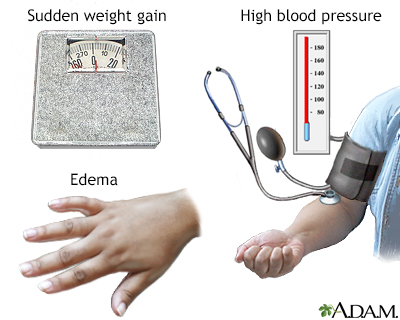Pregnancy SmartSiteTM
DefinitionHELLP syndrome is a group of symptoms that occur in pregnant women who have:
CausesThe cause of HELLP syndrome has not been found. It is considered to be a variant of preeclampsia. Sometimes the presence of HELLP syndrome is due to an underlying disease, such as antiphospholipid syndrome. HELLP syndrome occurs in about 1 to 2 out of 1,000 pregnancies. In women with preeclampsia or eclampsia, the condition develops in 10% to 20% of pregnancies. Risk factors for HELLP syndrome include:
Most often, HELLP develops during the third trimester of pregnancy (between 26 to 40 weeks gestation). Sometimes it develops in the week after the baby is born. Many women have high blood pressure and are diagnosed with preeclampsia before they develop HELLP syndrome. In some cases, HELLP symptoms are the first warning of preeclampsia. The condition is sometimes misdiagnosed as:
SymptomsSymptoms include:
Exams and TestsDuring a physical exam, the health care provider may discover:
Liver function tests (liver enzymes) may be high. Platelet counts may be low. A CT scan may show bleeding into the liver. Excessive protein may be found in the urine. Tests of the baby's health will be done. Tests include fetal non-stress test and ultrasound, among others. TreatmentThe main treatment is to deliver the baby as soon as possible, even if the baby is premature. Problems with the liver and other complications of HELLP syndrome can quickly get worse and be harmful to both the mother and child. Your provider may induce labor by giving you medicines to start labor, or may perform a C-section. You may also receive:
Outlook (Prognosis)Outcomes are most often good if the problem is diagnosed early. It is very important to have regular prenatal checkups. You should also let your provider know right away if you have symptoms of this condition. When the condition is not treated early, up to 1 of 4 women develop serious complications. Without treatment, a small number of women die. The death rate among babies born to mothers with HELLP syndrome depends on birth weight and the development of the baby's organs, especially the lungs. Many babies are born prematurely (born before 37 weeks of pregnancy). HELLP syndrome may return in up to 1 out of 4 future pregnancies. Possible ComplicationsThere can be complications before and after the baby is delivered, including:
After the baby is born, HELLP syndrome goes away in most cases in 2 to 3 days. When to Contact a Medical ProfessionalIf symptoms of HELLP syndrome occur during pregnancy:
There is no known way to prevent HELLP syndrome. All pregnant women should start prenatal care early and continue it through the pregnancy. This allows the provider to find and treat conditions such as HELLP syndrome right away. ReferencesMehra S, Reinus JF. Gastrointestinal and hepatic disorders in the pregnant patient. In: Feldman M, Friedman LS, Brandt LJ, eds. Sleisenger and Fordtran's Gastrointestinal and Liver Disease. 11th ed. Philadelphia, PA: Elsevier; 2021:chap 40. Sibai BM. Preeclampsia and hypertensive disorders. In: Landon MB, Galan HL, Jauniaux ERM, et al, eds. Gabbe's Obstetrics: Normal and Problem Pregnancies. 8th ed. Philadelphia, PA: Elsevier; 2021:chap 38. | |
| |
Review Date: 11/10/2022 Reviewed By: John D. Jacobson, MD, Department of Obstetrics and Gynecology, Loma Linda University School of Medicine, Loma Linda, CA. Also reviewed by David C. Dugdale, MD, Medical Director, Brenda Conaway, Editorial Director, and the A.D.A.M. Editorial team. The information provided herein should not be used during any medical emergency or for the diagnosis or treatment of any medical condition. A licensed medical professional should be consulted for diagnosis and treatment of any and all medical conditions. Links to other sites are provided for information only -- they do not constitute endorsements of those other sites. No warranty of any kind, either expressed or implied, is made as to the accuracy, reliability, timeliness, or correctness of any translations made by a third-party service of the information provided herein into any other language. © 1997- A.D.A.M., a business unit of Ebix, Inc. Any duplication or distribution of the information contained herein is strictly prohibited. | |

 Preeclampsia
Preeclampsia
